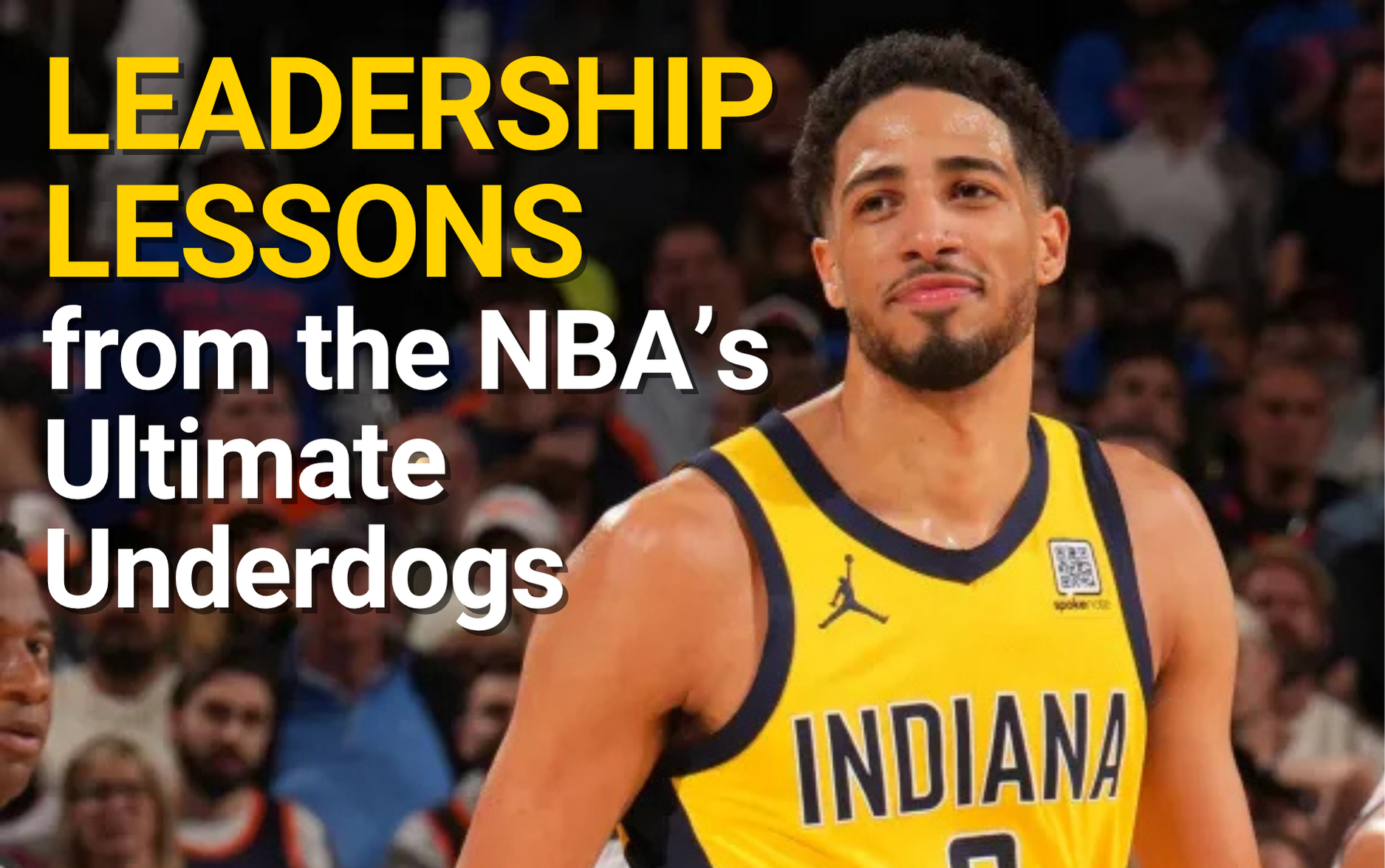
If you had told 15-year-old me—sitting in the nosebleeds at Market Square Arena with a $5 ticket and a foam finger—that the Indiana Pacers would be back in the NBA Finals in 2025, I would’ve believed you. Not because the odds were in our favor, but because that’s what fans do: we believe.
Fast forward many years later, and here we are. The Pacers are in the Finals for the first time since 2000, chasing their first NBA championship.
As an Indiana native and lifelong “Hoosier”, this run has been absolutely surreal. To see this current Pacers squad, under the brilliant guidance of Rick Carlisle and GM Chad Buchanan, not only improve year-over-year but truly dominate the Eastern Conference… it’s pure magic.
For a small-market team that has never won a championship, this isn’t just a sports story; it’s a testament to leadership, grit, and a unique approach to building a winning organization.
So, to celebrate their incredible journey, and perhaps convince a few more business leaders to don some blue and gold, I wanted to share why every great leader should be rooting for the Pacers this year.
The Underdog Mentality: Turning Constraints into Catalysts
At its heart, the Pacers’ story is the ultimate underdog tale. And most of the good leaders I know naturally gravitate towards these narratives. We understand the uphill battles, the resource constraints, and the immense pressure to outperform. This isn’t a team built on mega-stars or the biggest payrolls. It is the “Hoosiers” story personified – a collective of hard-working, often under-the-radar talent that embodies the spirit of resilience.
It reminds me of Malcolm Gladwell’s David and Goliath, where he explores how apparent disadvantages can actually be powerful strengths.
Historically, teams have had to shell out more money to win. Not so for the Pacers. For context, the Indiana Pacers’ 2024-2025 payroll hovers around $169 million, ranking them in the bottom half of the league. Compare that to a team they just dispatched, like the New York Knicks, whose payroll was over $188 million. (Source).
This financial disparity isn’t a weakness; it’s a crucible that has forged a disciplined, innovative approach to team building. And that, my friends, is where the real leadership lessons begin.
Despite their success, the Pacers would still be the largest underdogs ever to win the NBA Finals if they can overcome the NBA’s best team of 2025, the Oklahoma City Thunder.
From Good to Great: Leadership Principles in Action
This Pacers team isn’t just good; they’re demonstrating principles that Jim Collins would recognize as hallmarks of a “Good to Great” enterprise. Their success is a masterclass in how leadership can cultivate excellence, regardless of the industry or the size of your budget.
1. Roster Construction: Depth Over Superstars (Knowing Your Culture & Strengths)
Unlike previous championship blueprints (think the Golden State Warriors’ “Super Team” era or the early 2010s Miami Heat’s “Big Three”), the Pacers haven’t relied on stacking three of the league’s absolute biggest names. Instead, they’ve meticulously assembled a deep roster of complementary talent where every player understands their role and contributes to a cohesive whole. Their focus has been on cultural fit and building a system where individual strengths are amplified by collective synergy.
This approach mirrors effective talent management in business: sometimes, the perfect blend of specialized skills and shared values, rather than just chasing “rockstar” hires, creates a more resilient and high-performing team. It’s about building a versatile ecosystem, not just collecting shiny objects.
2. Team-Oriented Mentality: No Ego, Just Execution
If you’ve watched any Pacers game, you’ll quickly notice it’s never about one person’s stats or personal accolades. This is a genuinely “team-first” unit. Every game, it seems like a different player steps into the spotlight, whether it’s a critical defensive stop, a timely three-pointer, or a clutch assist. Their offense, which boasts one of the highest assist rates in the league, is a testament to unselfish play and constant ball movement – a direct reflection of their “we over me” philosophy. In the post-game interviews, it’s never about individual glory; it’s always about the collective effort.
This unselfishness is a powerful lesson for any organization: when individual egos are checked at the door, and everyone is focused on contributing to the shared objective, true collective potential is unlocked.
3. Strategic Patience and Unwavering Vision (No Knee-Jerk Reactions)
In an era of instant gratification and quick fixes, the Pacers have demonstrated remarkable strategic patience. After being swept by the Celtics in last year’s Eastern Conference Finals, GM Chad Buchanan didn’t make any knee-jerk moves (which is common) to overhaul their roster. Instead, they doubled down on development and cohesion. Even significant roster moves, like the mid-season acquisition of Pascal Siakam, were calculated decisions that fit their existing system and culture, rather than desperate, reactive plays.
Too often, I see organizations abandon ship when a strategy or idea doesn’t pay off immediately rather than making small pivots and staying the course. The Pacers steadfast commitment to a well-defined plan, understanding that true organizational growth isn’t always linear, but requires unwavering focus on the ultimate “goal,” is a vital lesson for any leader navigating challenging periods.
4. Tyrese Haliburton’s Masterclass in Humility & Motivation
Perhaps no player on the team embodies the “Good to Great” ethos more than Tyrese Haliburton. Earlier this year, in an anonymous player poll, he was shockingly voted the “most overrated player” in the NBA. Let that sink in. The leader of an NBA Finals team was deemed “overrated” by his peers. How did he respond? With quiet determination, humility, and an unwavering focus on his craft and his team. He used that external perception as fuel, not as a reason to abandon his game or become defensive. His performance has soared, leading the league in assists, commanding the offense, and demonstrating exceptional poise under pressure.
For leaders, Haliburton is a living example of how to handle criticism: stay humble and let your performance speak for itself. True leadership isn’t about accolades; it’s about impact, especially when the chips are down.
5. Exemplifying the “Good to Great” Transition
The Pacers’ journey perfectly aligns with Jim Collins’ principles. They are a “Level 5” organization in the making – humble, disciplined, and focused on building enduring greatness. They don’t seek the spotlight; they simply execute with relentless discipline. They exemplify the idea of the “flywheel effect,” building momentum step-by-step through consistent, fundamental efforts rather than relying on a single, dramatic breakthrough. Their approachable demeanor, both individually and as a team, coupled with a fierce commitment to continuous improvement, makes them the ideal embodiment of what it means to transition from “good” to truly “great.” They are a prime example of an organization where collective effort and disciplined execution trump individual fame.
More Than Just a Game
The Pacers’ journey to the 2025 NBA Finals is more than a sports story; it’s a testament to what can be achieved with vision, resilience, and unwavering commitment. For leaders in any field, their example serves as a powerful reminder that success isn’t solely about resources—it’s about how you use them.
So, whether you’re a basketball fan or a business leader, there’s a lot to admire in this Pacers team. And if you’re looking for a team to root for, consider the one that’s showing us all how to lead with purpose and passion. Go Pacers!
By Kent Wilson
